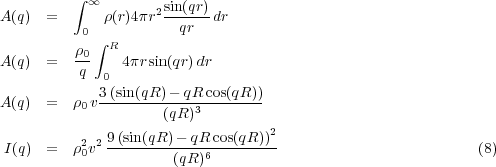
Using Equation 7, we can determine the scattered intensity for a solid sphere of radius R with a uniform density ρ0 for r ≤ R.
Zeros of the function occur where qR = tan(qR) as shown in Figure 2
For a rod, the expression is given by
where

For a thin circular disk, the scattered intensity is given in Equation 10 where J1 is the first order Bessel function.
|
|
At high q, the intensity scales as I(q) ~ q-α where α = 4 for spheres, 2 for thin disks and 1 for rods. At small q, the intensities are independent of the shape of the particles, if plotted as a function of qRg, which provides the basis for the Guinier law.